Android Studio類微信介面設計
2020-10-16 12:00:47
文章目錄
一、類微信介面能實現的功能
Android Studio設計的微信類介面應該具備的功能:
1、可以展示出微信、朋友、通訊錄、設定四個主介面;
2、可以在四個主介面之間自由切換;
3、介面上方欄有標題居中,介面中間顯示內容,內容隨下方欄的選擇而切換,介面下方欄分成四個小板塊可點選切換,且正在使用的介面的圖示為綠色,沒有使用的介面的圖示為灰色。
二、xml程式碼
top.xml
介面上方欄居中寫標題。
<?xml version="1.0" encoding="utf-8"?>
<LinearLayout xmlns:android="http://schemas.android.com/apk/res/android"
android:layout_width="match_parent"
android:layout_height="65dp"
android:gravity="center"
android:background="#000000"
android:orientation="vertical">
<TextView
android:id="@+id/textView"
android:layout_width="wrap_content"
android:layout_height="wrap_content"
android:layout_gravity="center_horizontal"
android:text="@string/app_name"
android:textColor="#ffffff"
android:textSize="20sp" />
</LinearLayout>
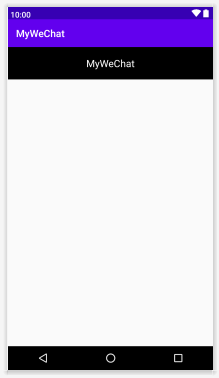
bottom.xml
介面下方欄分成四個小板塊可點選切換,且正在使用的介面的圖示為綠色,沒有使用的介面的圖示為灰色。用LinearLayout中巢狀LinearLayout。
<?xml version="1.0" encoding="utf-8"?>
<LinearLayout xmlns:android="http://schemas.android.com/apk/res/android"
xmlns:app="http://schemas.android.com/apk/res-auto"
android:layout_width="match_parent"
android:layout_height="80dp"
android:background="@drawable/bottom_bar"
android:orientation="horizontal"
android:baselineAligned="false">
<LinearLayout
android:id="@+id/id_tab_weixin"
android:layout_width="0dp"
android:layout_height="match_parent"
android:layout_weight="1"
android:gravity="center"
android:orientation="vertical">
<ImageButton
android:id="@+id/id_tab_weixin_img"
android:layout_width="match_parent"
android:layout_height="wrap_content"
android:background="#000000"
android:clickable="false"
android:contentDescription="@string/app_name"
app:srcCompat="@drawable/tab_weixin_pressed" />
<TextView
android:id="@+id/textView1"
android:layout_width="match_parent"
android:layout_height="wrap_content"
android:layout_gravity="center_horizontal"
android:gravity="center"
android:text="微信"
android:textColor="#ffffff"
android:clickable="false"
android:textSize="15sp" />
</LinearLayout>
<LinearLayout
android:id="@+id/id_tab_frd"
android:layout_width="0dp"
android:layout_height="match_parent"
android:layout_weight="1"
android:gravity="center"
android:orientation="vertical">
<ImageButton
android:id="@+id/id_tab_frd_img"
android:layout_width="match_parent"
android:layout_height="wrap_content"
android:background="#000000"
android:clickable="false"
android:contentDescription="@string/app_name"
app:srcCompat="@drawable/tab_find_frd_normal" />
<TextView
android:id="@+id/textView2"
android:layout_width="match_parent"
android:layout_height="wrap_content"
android:layout_gravity="center_horizontal"
android:gravity="center"
android:text="朋友"
android:textColor="#ffffff"
android:clickable="false"
android:textSize="15sp" />
</LinearLayout>
<LinearLayout
android:id="@+id/id_tab_contact"
android:layout_width="0dp"
android:layout_height="match_parent"
android:gravity="center"
android:layout_weight="1"
android:orientation="vertical">
<ImageButton
android:id="@+id/id_tab_contact_img"
android:layout_width="match_parent"
android:layout_height="wrap_content"
android:background="#000000"
android:clickable="false"
android:contentDescription="@string/app_name"
app:srcCompat="@drawable/tab_address_normal" />
<TextView
android:id="@+id/textView3"
android:layout_width="match_parent"
android:layout_height="wrap_content"
android:layout_gravity="center_horizontal"
android:gravity="center"
android:text="通訊錄"
android:textColor="#ffffff"
android:clickable="false"
android:textSize="15sp" />
</LinearLayout>
<LinearLayout
android:id="@+id/id_tab_settings"
android:layout_width="0dp"
android:layout_height="match_parent"
android:gravity="center"
android:layout_weight="1"
android:orientation="vertical">
<ImageButton
android:id="@+id/id_tab_settings_img"
android:layout_width="match_parent"
android:layout_height="wrap_content"
android:background="#000000"
android:clickable="false"
android:contentDescription="@string/app_name"
app:srcCompat="@drawable/tab_settings_normal" />
<TextView
android:id="@+id/textView4"
android:layout_width="match_parent"
android:layout_height="wrap_content"
android:layout_gravity="center_horizontal"
android:gravity="center"
android:text="設定"
android:textColor="#ffffff"
android:clickable="false"
android:textSize="15sp" />
</LinearLayout>
</LinearLayout>
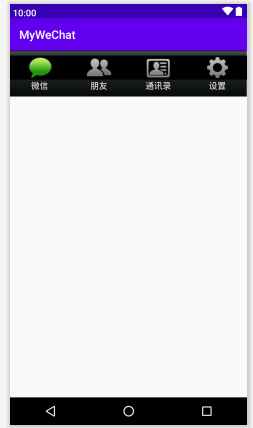
tab.xml
介面中間顯示內容,有四個主介面所以要有四個tab.xml分別對應。四個tab.xml程式碼基本一樣只需要修改文字內容即可,這兒就只展示了第一個微信介面的tab01.xml。
<?xml version="1.0" encoding="utf-8"?>
<LinearLayout xmlns:android="http://schemas.android.com/apk/res/android"
android:layout_width="match_parent"
android:layout_height="match_parent"
android:gravity="center"
android:orientation="horizontal">
<TextView
android:id="@+id/textView5"
android:layout_width="wrap_content"
android:layout_height="wrap_content"
android:layout_gravity="center"
android:layout_weight="1"
android:gravity="center"
android:text="這是微信聊天介面"
android:textSize="25sp" />
</LinearLayout>
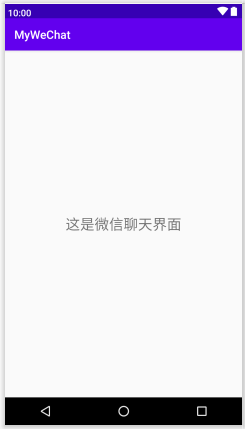
activity_main.xml
主介面需要用到外掛FrameLayout和include。
<?xml version="1.0" encoding="utf-8"?>
<LinearLayout xmlns:android="http://schemas.android.com/apk/res/android"
android:layout_width="match_parent"
android:layout_height="65dp"
android:gravity="center"
android:background="#000000"
android:orientation="vertical">
<TextView
android:id="@+id/textView"
android:layout_width="wrap_content"
android:layout_height="wrap_content"
android:layout_gravity="center_horizontal"
android:text="@string/app_name"
android:textColor="#ffffff"
android:textSize="20sp" />
</LinearLayout>
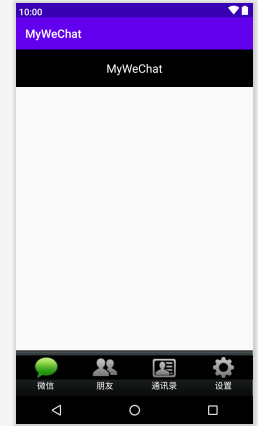
三、Java程式碼
MainActivity.java
package com.example.mywechat;
import androidx.appcompat.app.AppCompatActivity;
import android.app.Fragment;
import android.app.FragmentManager;
import android.app.FragmentTransaction;
import android.os.Bundle;
import android.view.View;
import android.view.Window;
import android.widget.ImageButton;
import android.widget.LinearLayout;
public class MainActivity extends AppCompatActivity implements View.OnClickListener {
private Fragment mTab01 = new weixinFragment();
private Fragment mTab02 = new frdFragment();
private Fragment mTab03 = new contactFragment();
private Fragment mTab04 = new settingsFragment();
private FragmentManager fm;
private LinearLayout mTabweixin;
private LinearLayout mTabfrd;
private LinearLayout mTabcontact;
private LinearLayout mTabsettings;
private ImageButton mImgTabweixin;
private ImageButton mImgTabfrd;
private ImageButton mImgTabcontact;
private ImageButton mImgTabsettings;
@Override
protected void onCreate(Bundle savedInstanceState) {
super.onCreate(savedInstanceState);
requestWindowFeature(Window.FEATURE_NO_TITLE );
setContentView(R.layout.activity_main);
initView();
initFragment();
initEvent();
selectfragment(0);
}
private void initFragment(){
fm = getFragmentManager();
FragmentTransaction transaction = fm.beginTransaction();
transaction.add(R.id.id_content, mTab01);
transaction.add(R.id.id_content, mTab02);
transaction.add(R.id.id_content, mTab03);
transaction.add(R.id.id_content, mTab04);
transaction.commit();
}
private void initView(){
mTabweixin=(LinearLayout) findViewById(R.id.id_tab_weixin);
mTabfrd=(LinearLayout) findViewById(R.id.id_tab_frd);
mTabcontact=(LinearLayout) findViewById(R.id.id_tab_contact);
mTabsettings=(LinearLayout) findViewById(R.id.id_tab_settings);
mImgTabweixin = (ImageButton)findViewById(R.id.id_tab_weixin_img);
mImgTabfrd = (ImageButton)findViewById(R.id.id_tab_frd_img);
mImgTabcontact = (ImageButton)findViewById(R.id.id_tab_contact_img);
mImgTabsettings = (ImageButton)findViewById(R.id.id_tab_settings_img);
}
private void initEvent(){
mTabweixin.setOnClickListener(this);
mTabfrd.setOnClickListener(this);
mTabcontact.setOnClickListener(this);
mTabsettings.setOnClickListener(this);
}
private void hideFragment(FragmentTransaction transaction) {
transaction.hide(mTab01);
transaction.hide(mTab02);
transaction.hide(mTab03);
transaction.hide(mTab04);
}
private void selectfragment(int i){
FragmentTransaction transaction = fm.beginTransaction();
hideFragment(transaction);
//把圖片設定為亮的
//設定內容區域
switch (i){
case 0:
transaction.show(mTab01);
mImgTabweixin.setImageResource(R.drawable.tab_weixin_pressed);
break;
case 1:
transaction.show(mTab02);
mImgTabfrd.setImageResource(R.drawable.tab_find_frd_pressed);
break;
case 2:
transaction.show(mTab03);
mImgTabcontact.setImageResource(R.drawable.tab_address_pressed);
break;
case 3:
transaction.show(mTab04);
mImgTabsettings.setImageResource(R.drawable.tab_settings_pressed);
break;
default:
break;
}
transaction.commit();
}
@Override
public void onClick(View view) {
resetimg();
switch (view.getId()){
case R.id.id_tab_weixin:
selectfragment(0);
break;
case R.id.id_tab_frd:
selectfragment(1);
break;
case R.id.id_tab_contact:
selectfragment(2);
break;
case R.id.id_tab_settings:
selectfragment(3);
break;
}
}
public void resetimg(){
//圖片變灰
mImgTabweixin.setImageResource(R.drawable.tab_weixin_normal);
mImgTabfrd.setImageResource(R.drawable.tab_find_frd_normal);
mImgTabcontact.setImageResource(R.drawable.tab_address_normal);
mImgTabsettings.setImageResource(R.drawable.tab_settings_normal);
}
}
介紹一下各個函數的作用,initFragment函數中利用transaction來實現fragment的切換;initView改變圖示的顏色;selectfragment顯示正在使用介面的fragment的內容,並且讓正在使用的介面的圖示為綠色;hideFragment把沒有使用的介面的fragment的內容隱藏起來;resetimg讓沒有使用的介面的圖示為灰色;onClick監聽函數,監聽到底是哪一個圖示被擊中從而顯示哪一個介面的內容。
weixinFragment
呼叫tab01
package com.example.mywechat;
import android.os.Bundle;
import android.app.Fragment;
import android.view.LayoutInflater;
import android.view.View;
import android.view.ViewGroup;
public class weixinFragment extends Fragment {
private static final String ARG_PARAM1 = "param1";
private static final String ARG_PARAM2 = "param2";
private String mParam1;
private String mParam2;
public weixinFragment() {
// Required empty public constructor
}
/**
* Use this factory method to create a new instance of
* this fragment using the provided parameters.
*
* @param param1 Parameter 1.
* @param param2 Parameter 2.
* @return A new instance of fragment weixinFragment.
*/
// TODO: Rename and change types and number of parameters
public static weixinFragment newInstance(String param1, String param2) {
weixinFragment fragment = new weixinFragment();
Bundle args = new Bundle();
args.putString(ARG_PARAM1, param1);
args.putString(ARG_PARAM2, param2);
fragment.setArguments(args);
return fragment;
}
@Override
public void onCreate(Bundle savedInstanceState) {
super.onCreate(savedInstanceState);
if (getArguments() != null) {
mParam1 = getArguments().getString(ARG_PARAM1);
mParam2 = getArguments().getString(ARG_PARAM2);
}
}
@Override
public View onCreateView(LayoutInflater inflater, ViewGroup container,
Bundle savedInstanceState) {
// Inflate the layout for this fragment
return inflater.inflate(R.layout.tab01, container, false);
}
}
frdFragment
呼叫tab02
package com.example.mywechat;
import android.os.Bundle;
import android.view.LayoutInflater;
import android.view.View;
import android.view.ViewGroup;
import android.app.Fragment;
public class frdFragment extends Fragment {
// TODO: Rename parameter arguments, choose names that match
// the fragment initialization parameters, e.g. ARG_ITEM_NUMBER
private static final String ARG_PARAM1 = "param1";
private static final String ARG_PARAM2 = "param2";
// TODO: Rename and change types of parameters
private String mParam1;
private String mParam2;
public frdFragment() {
// Required empty public constructor
}
/**
* Use this factory method to create a new instance of
* this fragment using the provided parameters.
*
* @param param1 Parameter 1.
* @param param2 Parameter 2.
* @return A new instance of fragment weixinFragment.
*/
// TODO: Rename and change types and number of parameters
public static frdFragment newInstance(String param1, String param2) {
frdFragment fragment = new frdFragment();
Bundle args = new Bundle();
args.putString(ARG_PARAM1, param1);
args.putString(ARG_PARAM2, param2);
fragment.setArguments(args);
return fragment;
}
@Override
public void onCreate(Bundle savedInstanceState) {
super.onCreate(savedInstanceState);
if (getArguments() != null) {
mParam1 = getArguments().getString(ARG_PARAM1);
mParam2 = getArguments().getString(ARG_PARAM2);
}
}
@Override
public View onCreateView(LayoutInflater inflater, ViewGroup container,
Bundle savedInstanceState) {
// Inflate the layout for this fragment
return inflater.inflate(R.layout.tab02, container, false);
}
}
contactFragment
呼叫tab03
package com.example.mywechat;
import android.os.Bundle;
import android.view.LayoutInflater;
import android.view.View;
import android.view.ViewGroup;
import android.app.Fragment;
public class contactFragment extends Fragment {
// TODO: Rename parameter arguments, choose names that match
// the fragment initialization parameters, e.g. ARG_ITEM_NUMBER
private static final String ARG_PARAM1 = "param1";
private static final String ARG_PARAM2 = "param2";
// TODO: Rename and change types of parameters
private String mParam1;
private String mParam2;
public contactFragment() {
// Required empty public constructor
}
/**
* Use this factory method to create a new instance of
* this fragment using the provided parameters.
*
* @param param1 Parameter 1.
* @param param2 Parameter 2.
* @return A new instance of fragment weixinFragment.
*/
// TODO: Rename and change types and number of parameters
public static contactFragment newInstance(String param1, String param2) {
contactFragment fragment = new contactFragment();
Bundle args = new Bundle();
args.putString(ARG_PARAM1, param1);
args.putString(ARG_PARAM2, param2);
fragment.setArguments(args);
return fragment;
}
@Override
public void onCreate(Bundle savedInstanceState) {
super.onCreate(savedInstanceState);
if (getArguments() != null) {
mParam1 = getArguments().getString(ARG_PARAM1);
mParam2 = getArguments().getString(ARG_PARAM2);
}
}
@Override
public View onCreateView(LayoutInflater inflater, ViewGroup container,
Bundle savedInstanceState) {
// Inflate the layout for this fragment
return inflater.inflate(R.layout.tab03, container, false);
}
}
settingsFragment
呼叫tab04
package com.example.mywechat;
import android.os.Bundle;
import android.view.LayoutInflater;
import android.view.View;
import android.view.ViewGroup;
import android.app.Fragment;
public class settingsFragment extends Fragment {
// TODO: Rename parameter arguments, choose names that match
// the fragment initialization parameters, e.g. ARG_ITEM_NUMBER
private static final String ARG_PARAM1 = "param1";
private static final String ARG_PARAM2 = "param2";
// TODO: Rename and change types of parameters
private String mParam1;
private String mParam2;
public settingsFragment() {
// Required empty public constructor
}
/**
* Use this factory method to create a new instance of
* this fragment using the provided parameters.
*
* @param param1 Parameter 1.
* @param param2 Parameter 2.
* @return A new instance of fragment weixinFragment.
*/
// TODO: Rename and change types and number of parameters
public static settingsFragment newInstance(String param1, String param2) {
settingsFragment fragment = new settingsFragment();
Bundle args = new Bundle();
args.putString(ARG_PARAM1, param1);
args.putString(ARG_PARAM2, param2);
fragment.setArguments(args);
return fragment;
}
@Override
public void onCreate(Bundle savedInstanceState) {
super.onCreate(savedInstanceState);
if (getArguments() != null) {
mParam1 = getArguments().getString(ARG_PARAM1);
mParam2 = getArguments().getString(ARG_PARAM2);
}
}
@Override
public View onCreateView(LayoutInflater inflater, ViewGroup container,
Bundle savedInstanceState) {
// Inflate the layout for this fragment
return inflater.inflate(R.layout.tab04, container, false);
}
}
四、執行介面展示
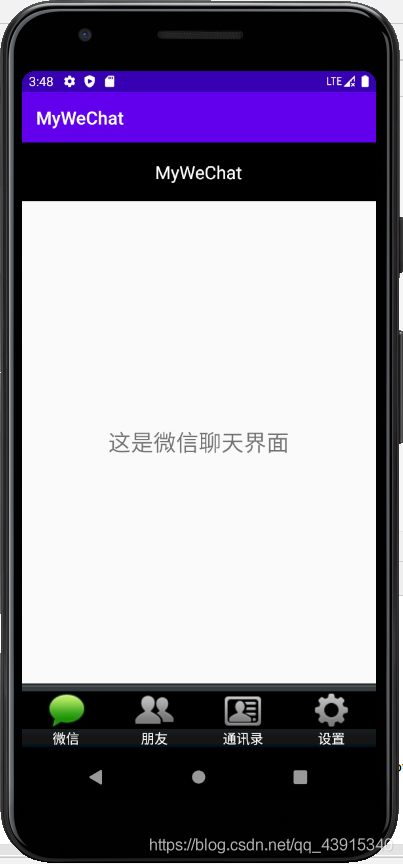

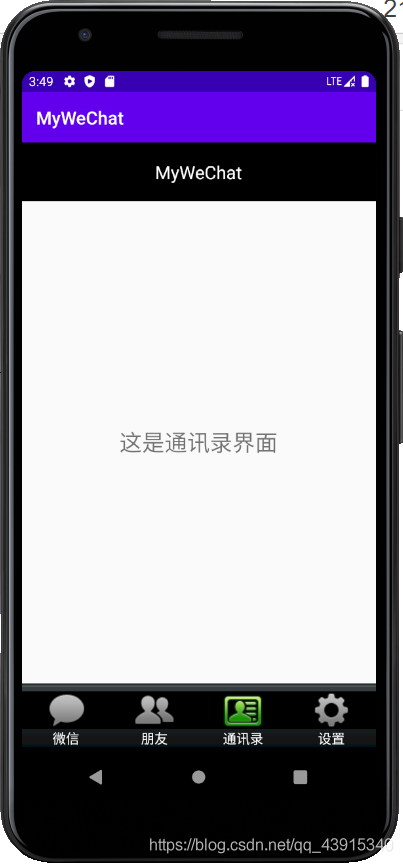
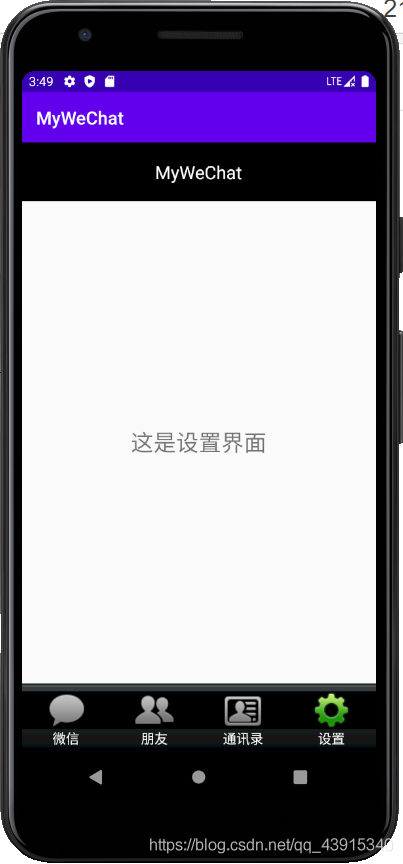
最後附上原始碼的程式碼倉庫地址(碼雲)
連結:https://gitee.com/yuiaikn/android